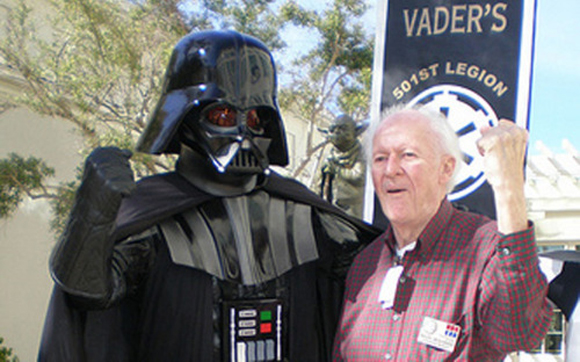There’s a hunger that Star Wars creates in its fans — especially the young ones — that George Lucas can’t fill. It’s a hunger to go far beyond the boundaries of the movies and wander through the vast spaces that the Skywalkers’ story merely hints at.But for decades, Lucas has made sure all licensed Star Wars fiction roughly connects back to his canonical stories. Almighty George is a bit too much of a Steve Jobs type — for him, Star Wars is a closed system that must remain controlled and on-brand. That’s why Ralph McQuarrie was so important: he was the open-source alternative.McQuarrie — who died Saturday at age 82 — was a painter and former technical illustrator who did concept art for a wide range of movies, but he was most famous for his work on the original Star Wars trilogy. He left his drawings on the inside of your head. Close your eyes and picture Darth Vader, C-3PO, or a Stormtrooper — whatever you just envisioned was originally drawn by McQuarrie, along with countless other landscapes, characters, and objects from the series. You could argue that he was Star Wars’ second-most important creator after Lucas.But what made him truly special was his ability to dream beyond whatever Lucas typed out. His drawings depicted nooks and crannies of the Galaxy that had absolutely nothing to do with Jedi or Sith, Rebels or Empire. He constantly went off-model (or put brush to canvas before a finished model existed). His drawings were wordless and offered no binding interpretations. He uncorked the bottle and, in doing so, let viewers become their own creators. Nowhere was that fertility more on display than in 1995’s The Illustrated Star Wars Universe. It was a hardcover coffee table book, primarily a showcase for 200-odd pages of lesser-known McQuarrie concept art.It’s a weird read. The book is divided up by planet and features long tracts of in-character text from sci-fi scribe Kevin J. Anderson. For example, the chapter on Dagobah treats McQuarrie’s art as illustrations from a report left behind by an ill-fated Old Republic research mission. The images of Tatooine are accompanied by a planetary study from a shape-shifting anthropologist. And so on.Anderson’s attempts to stuff McQuarrie’s art into Lucas-approved canon are admirable, but ultimately miss the point. There’s already too much over-explaining in the Star Wars universe, and the paintings are simply there to act as a launching pad for your imagination.He depicted places we’d never visit if we just followed Lucas’s family saga and its tangents: cloudy breezeways above the treeline on Dagobah, gargantuan water pipes near the polar ice caps of Coruscant, a placid twilight congregation of Sand People.
Nowhere was that fertility more on display than in 1995’s The Illustrated Star Wars Universe. It was a hardcover coffee table book, primarily a showcase for 200-odd pages of lesser-known McQuarrie concept art.It’s a weird read. The book is divided up by planet and features long tracts of in-character text from sci-fi scribe Kevin J. Anderson. For example, the chapter on Dagobah treats McQuarrie’s art as illustrations from a report left behind by an ill-fated Old Republic research mission. The images of Tatooine are accompanied by a planetary study from a shape-shifting anthropologist. And so on.Anderson’s attempts to stuff McQuarrie’s art into Lucas-approved canon are admirable, but ultimately miss the point. There’s already too much over-explaining in the Star Wars universe, and the paintings are simply there to act as a launching pad for your imagination.He depicted places we’d never visit if we just followed Lucas’s family saga and its tangents: cloudy breezeways above the treeline on Dagobah, gargantuan water pipes near the polar ice caps of Coruscant, a placid twilight congregation of Sand People. Even familiar sights were made strange by their placement in unexpected contexts. AT-ATs were on the march through Hoth, but nowhere near the Rebel base — they trod near ice-mountains in eerie, moonlit silence. Had they been separated from the rest of the group? Was this a preparatory exercise before the main event the next morning? Sky platforms hung near Cloud City, but humanoid figures on leather-winged lizards swooped nearby. Were these the true natives of the planet? What was their way of life, so far from anything we’d call ground? The mind wandered, unencumbered, and it was marvelous.Of course, this is not to say McQuarrie’s Star Wars work was entirely unique. He owed a great debt to the fantasy landscapes of Roger Dean and Frank Frazetta (and, perhaps, NASA artist Robert McCall). He never played with texture and perspective like contemporaries such as Moebius and H.R. Giger. But he was a visionary, nonetheless. Just take a look at the way he painted the city-world of Coruscant. Years before Blade Runner, he had already dreamed up images of an endless city, peppered with ziggurats and in near-constant sunset. One wants to walk through the squares and find stories that have nothing to do with the Force.
Even familiar sights were made strange by their placement in unexpected contexts. AT-ATs were on the march through Hoth, but nowhere near the Rebel base — they trod near ice-mountains in eerie, moonlit silence. Had they been separated from the rest of the group? Was this a preparatory exercise before the main event the next morning? Sky platforms hung near Cloud City, but humanoid figures on leather-winged lizards swooped nearby. Were these the true natives of the planet? What was their way of life, so far from anything we’d call ground? The mind wandered, unencumbered, and it was marvelous.Of course, this is not to say McQuarrie’s Star Wars work was entirely unique. He owed a great debt to the fantasy landscapes of Roger Dean and Frank Frazetta (and, perhaps, NASA artist Robert McCall). He never played with texture and perspective like contemporaries such as Moebius and H.R. Giger. But he was a visionary, nonetheless. Just take a look at the way he painted the city-world of Coruscant. Years before Blade Runner, he had already dreamed up images of an endless city, peppered with ziggurats and in near-constant sunset. One wants to walk through the squares and find stories that have nothing to do with the Force. Lucas left a remembrance of McQuarrie on the official Star Wars site yesterday, and like so much that he says, it’s gratingly egomaniacal. “When words could not convey my ideas,” he says at one point, “I could always point to one of Ralph’s fabulous illustrations and say, ‘Do it like this.’”
Lucas left a remembrance of McQuarrie on the official Star Wars site yesterday, and like so much that he says, it’s gratingly egomaniacal. “When words could not convey my ideas,” he says at one point, “I could always point to one of Ralph’s fabulous illustrations and say, ‘Do it like this.’” No, George — what was so great was that Ralph didn’t always just show off your ideas. He used those ideas as a starting point, not a hard framework. Why do you think the Star Wars: The Old Republic MMORPG has been such an unbelievable hit?People want to lose themselves in this fictional universe. Lucas may have thought up the Galaxy, but Ralph McQuarrie gave it color and made it truly enormous.
No, George — what was so great was that Ralph didn’t always just show off your ideas. He used those ideas as a starting point, not a hard framework. Why do you think the Star Wars: The Old Republic MMORPG has been such an unbelievable hit?People want to lose themselves in this fictional universe. Lucas may have thought up the Galaxy, but Ralph McQuarrie gave it color and made it truly enormous.
Advertisement

Advertisement

Advertisement


